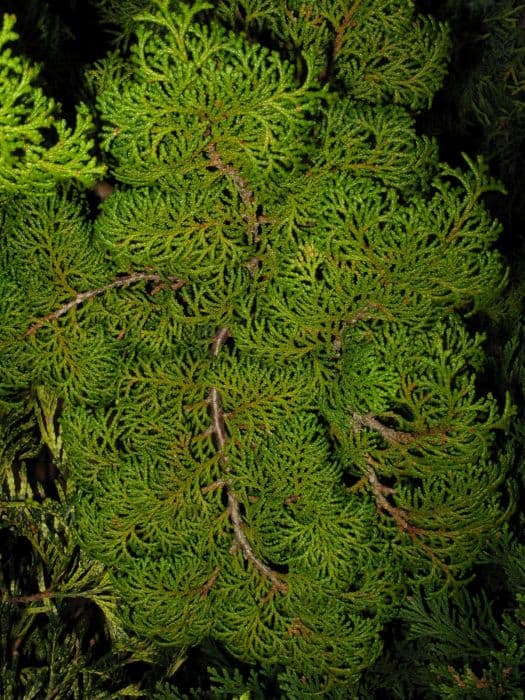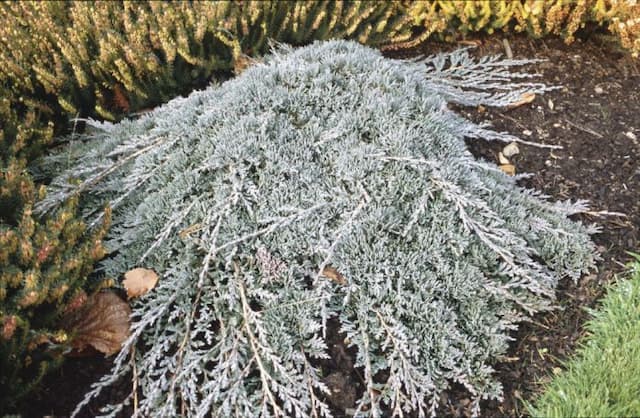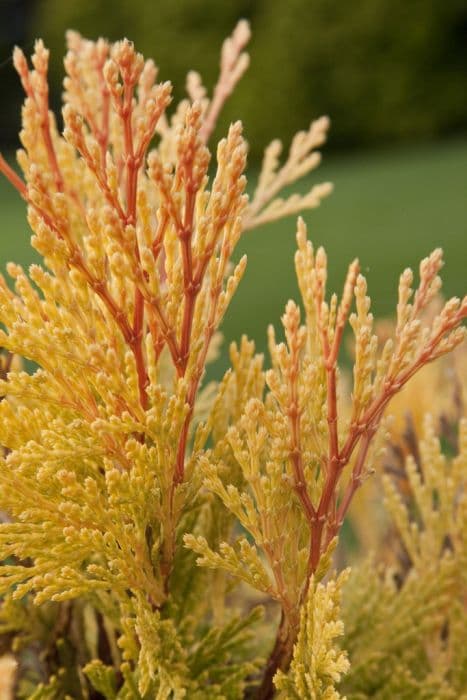Oriental thuja 'Elegantissima' Platycladus orientalis 'Elegantissima'











ABOUT
'Elegantissima' is a dense, conical evergreen conifer with golden-yellow tips to the erect sprays of foliage, becoming greener or brownish in winter
About this plant
 Names
NamesFamily
Cupressaceae.
Synonyms
Oriental Arborvitae, Chinese Arborvitae, Biota.
Common names
Thuja orientalis 'Elegantissima', Biota orientalis 'Elegantissima', Platycladus orientalis 'Aurea Nana', Thuja orientalis 'Aurea Nana'.
 Characteristics
CharacteristicsLife cycle
Perennials
Foliage type
Evergreen
Color of leaves
Variegated
Height
10-15 feet (3-4.5 meters)
Spread
2-4 feet (0.6-1.2 meters)
Plant type
Tree
Hardiness zones
6
Native area
China
Benefits
 General Benefits
General Benefits- Aesthetic Appeal: The Chinese Arborvitae 'Elegantissima' offers striking foliage with yellow to creamy-white variegation, adding visual interest and contrast to garden spaces.
- Low Maintenance: Once established, it requires minimal care, making it an ideal choice for gardeners seeking low-maintenance landscaping options.
- Drought Tolerance: This plant is relatively drought tolerant, making it suitable for gardens in drier climates or for water-wise landscaping practices.
- Adaptability: It adapts well to a range of soil types and conditions, although it prefers well-drained soils.
- Privacy Screen: With its dense growth habit, it can be used to create a natural privacy screen or hedge.
- Year-Round Interest: Being an evergreen, it provides year-round color and structure in the landscape.
- Urban Tolerant: It can tolerate urban conditions like pollution and confined spaces, which is beneficial for city landscaping.
- Wildlife Support: The plant offers shelter to birds and other wildlife, enhancing biodiversity in the garden.
 Medical Properties
Medical Properties- Antimicrobial activity: Platycladus orientalis has been reported to exhibit antimicrobial properties against certain bacteria and fungi.
- Antioxidant effects: Extracts from the plant have shown antioxidant activity, which could help in protecting cells from oxidative damage.
- Anti-inflammatory properties: The plant may possess anti-inflammatory effects which could be beneficial in treating inflammatory conditions.
- Wound healing: There is some indication that Platycladus orientalis may promote wound healing due to its antimicrobial and anti-inflammatory actions.
 Air-purifying Qualities
Air-purifying QualitiesThis plant is not specifically known for air purifying qualities.
 Other Uses
Other Uses- Platycladus orientalis 'Elegantissima', commonly known as the Oriental Arborvitae, can be used to create intricate topiaries in ornamental gardens due to its dense foliage and ease of shaping.
- The wood of the Oriental Arborvitae is highly resistant to decay and can be used to make durable outdoor wooden structures such as fences, pergolas, and trellises.
- Its dense branches can serve as a natural privacy screen, providing an eco-friendly option to traditional fencing materials.
- Due to its ability to thrive in a range of soil types and conditions, Oriental Arborvitae is used for slope stabilization and erosion control in landscapes.
- The scales of its cones are sometimes used in crafting and as natural decorations in potpourri and wreaths.
- Oriental Arborvitae's dense canopies provide excellent shelter and nesting sites for a variety of bird species.
- The conifer's slow growth rate and compact habit make it ideal for use in model train layouts and other miniature landscapes.
- Its resistance to wind makes it a suitable species for creating windbreaks in agricultural fields and around rural properties.
- Its unique leaf color variations are sought after by bonsai enthusiasts, who train them into miniature living art forms.
- The sawdust and wood shavings from Oriental Arborvitae are often used in smoking meats for added flavor.
Interesting Facts
 Feng Shui
Feng ShuiThe Chinese Arborvitae is not used in Feng Shui practice.
 Zodiac Sign Compitability
Zodiac Sign CompitabilityThe Chinese Arborvitae is not used in astrology practice.
 Plant Symbolism
Plant Symbolism- Longevity: Platycladus orientalis 'Elegantissima', commonly known as the Oriental Arborvitae, is known for its long life, symbolizing endurance and the ability to withstand the test of time.
- Resilience: As a hardy evergreen, the Oriental Arborvitae represents the ability to persevere and thrive in adverse conditions, highlighting strength and adaptability.
- Peace and Tranquility: Often found in gardens and landscapes, its calming presence and aesthetic appeal associate it with tranquility and inner peace.
- Protection: Historically, evergreens like the Oriental Arborvitae were believed to ward off evil spirits, representing protection and safety.
- Eternal Life: The evergreen nature of the Arborvitae, which keeps its leaves throughout the year, symbolizes immortality and eternal life.
 Water
WaterThe Chinese Arborvitae, or Platycladus orientalis 'Elegantissima', should be watered deeply and infrequently to encourage strong root growth. During the first growing season, water the plant once a week with about 1.5 to 2 gallons of water, making adjustments for rainfall. Once established, water less frequently, aiming for about every two weeks unless there are extreme weather conditions like drought. During the winter months, reduce watering since the plant will be dormant. Always check the soil moisture before watering; it should be dry an inch below the surface.
 Light
LightThe Chinese Arborvitae prefers full sun to partial shade for optimal growth. It thrives when planted in a location that receives at least 6 hours of direct sunlight a day, but can also tolerate light shade. Avoid placing it in deep shade, as this can lead to sparse foliage and a less vigorous plant.
 Temperature
TemperatureThe Chinese Arborvitae is hardy and adaptable, enduring temperatures as low as -30°F and as high as 120°F. However, it grows best in the range of 60°F to 80°F. This plant can handle temperature extremes quite well once established, but younger plants should be protected from harsh conditions.
 Pruning
PruningPrune the Chinese Arborvitae to maintain a desired shape and size, and to remove any dead or damaged branches. Pruning is best done in the early spring before new growth starts. This plant generally requires light pruning every two or three years, but can be shaped annually if a more formal appearance is desired. Always use sharp, clean pruning tools to make clean cuts.
 Cleaning
CleaningAs needed
 Soil
SoilChinese Arborvitae 'Elegantissima' thrives in well-draining, loamy soil with a pH range of 6.0 to 8.0. A soil mix with equal parts garden soil, peat, and perlite or coarse sand is ideal to provide the necessary drainage and aeration.
 Repotting
RepottingChinese Arborvitae 'Elegantissima' should be repotted every 2 to 3 years to ensure healthy growth. Younger plants may require more frequent repotting, while mature specimens can be repotted less often.
 Humidity & Misting
Humidity & MistingChinese Arborvitae 'Elegantissima' prefers moderate humidity but is adaptable to various conditions. It can tolerate the typical humidity levels found in most home environments without needing any special adjustments.
 Suitable locations
Suitable locationsIndoor
Place Chinese Arborvitae in bright, indirect light indoors.
Outdoor
In an outdoor setting, ensure full sun to partial shade.
Hardiness zone
6-9 USDA
 Life cycle
Life cycleThe life of Platycladus orientalis 'Elegantissima', commonly known as the Oriental Arborvitae 'Elegantissima', begins as a seed, which requires a period of stratification to break dormancy and germinate. Upon germination, the seedling develops into a juvenile plant, exhibiting rapid growth and the development of its characteristic dense, variegated foliage that is a mix of green and creamy-yellow. As the plant matures, it enters a phase of slower, steady growth, eventually reaching up to 10-15 feet tall and 4-5 feet wide. Throughout its life, it undergoes seasonal changes, with some foliage turning brown and being shed, while new growth appears in spring. The Oriental Arborvitae 'Elegantissima' is monoecious, producing both male and female cones on the same plant, with the small, inconspicuous male cones releasing pollen and the larger female cones developing seeds that mature by autumn. The plant can live for many decades, with some specimens reaching over a hundred years in age, continuing the cycle when its seeds are dispersed and find suitable conditions to germinate.
 Propogation
PropogationPropogation time
Spring to Summer
Propogation: Platycladus orientalis 'Elegantissima', commonly known as the Oriental Arborvitae, is most successfully propagated using semi-hardwood cuttings. This type of propagation is typically conducted in late summer. To propagate from cuttings, a 4 to 6 inch length from a healthy branch is selected. The lower leaves are stripped, and the base of the cutting is dipped in rooting hormone to encourage root development. Then, the cutting is placed in a well-draining potting mix, ensuring good contact with the soil while keeping the environment humid and the soil lightly moist. Cuttings require a warm environment but must be kept out of direct sunlight until roots have developed, which typically takes several weeks. After rooting, the new plants can gradually acclimate to normal growing conditions before being transplanted into their final location.









